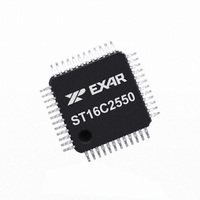ST16C2550IQ48-F Exar Corporation, ST16C2550IQ48-F Datasheet - Page 10

ST16C2550IQ48-F
Manufacturer Part Number
ST16C2550IQ48-F
Description
IC DUART FIFO 16B 48TQFP
Manufacturer
Exar Corporation
Type
RS- 232 or RS- 485r
Datasheet
1.ST16C2550CJ44-F.pdf
(37 pages)
Specifications of ST16C2550IQ48-F
Number Of Channels
2, DUART
Package / Case
48-TQFP
Features
*
Fifo's
16 Byte
Protocol
RS232, RS485
Voltage - Supply
2.97 V ~ 5.5 V
With False Start Bit Detection
Yes
With Modem Control
Yes
With Cmos
Yes
Mounting Type
Surface Mount
Data Rate
4 Mbps
Supply Voltage (max)
5.5 V
Supply Voltage (min)
2.97 V
Supply Current
3 mA
Maximum Operating Temperature
+ 85 C
Minimum Operating Temperature
- 40 C
Mounting Style
SMD/SMT
Operating Supply Voltage
3.3 V or 5 V
No. Of Channels
2
Supply Voltage Range
2.97V To 5.5V
Operating Temperature Range
-40°C To +85°C
Digital Ic Case Style
TQFP
No. Of Pins
48
Filter Terminals
SMD
Rohs Compliant
Yes
Lead Free Status / RoHS Status
Lead free / RoHS Compliant
Lead Free Status / RoHS Status
Lead free / RoHS Compliant, Lead free / RoHS Compliant
Other names
1016-1256
Available stocks
Company
Part Number
Manufacturer
Quantity
Price
Company:
Part Number:
ST16C2550IQ48-F
Manufacturer:
EXAR21
Quantity:
216
Company:
Part Number:
ST16C2550IQ48-F
Manufacturer:
Exar Corporation
Quantity:
10 000
Part Number:
ST16C2550IQ48-F
Manufacturer:
ST
Quantity:
20 000
ST16C2550
2.97V TO 5.5V DUART WITH 16-BYTE FIFO
The C2550 includes an on-chip oscillator (XTAL1 and XTAL2) to produce a clock for both UART sections in the
device. The CPU data bus does not require this clock for bus operation. The crystal oscillator provides a
system clock to the Baud Rate Generators (BRG) section found in each of the UART. XTAL1 is the input to the
oscillator or external clock buffer input with XTAL2 pin being the output.
Generator” on page 10.
The on-chip oscillator is designed to use an industry standard microprocessor crystal (parallel resonant,
fundamental frequency with 10-22 pF capacitance load, ESR of 20-120 ohms and 100ppm frequency
tolerance) connected externally between the XTAL1 and XTAL2 pins (see
1 MΩ resistor across it. Alternatively, an external clock can be connected to the XTAL1 pin to clock the internal
baud rate generator for standard or custom rates. Typical oscillator connections are shown in
further reading on oscillator circuit please see application note DAN108 on EXAR’s web site.
A single baud rate generator is provided for the transmitter and receiver, allowing independent TX/RX channel
control. The programmable Baud Rate Generator is capable of operating with a crystal frequency of up to 24
MHz. However, with an external clock input on XTAL1 pin and a 2K ohms pull-up resistor on XTAL2 pin (as
shown in
5.0V.
2.7
2.8
Crystal Oscillator or External Clock Input
Programmable Baud Rate Generator
Figure
5) it can extend its operation up to 64 MHz (4Mbps serial data rate) at room temperature and
F
IGURE
22-47 pF
XTAL1
4. T
C1
YPICAL OSCILLATOR CONNECTIONS
500 Κ Ω − 1 Μ Ω
R2
22-47 pF
10
XTAL2
C2
Y1
1.8432 MHz
(Optional)
0-120
24 MHz
R1
to
Ω
Figure
See “Programmable Baud Rate
4), with an external 500kΩ to
Figure
REV. 4.4.1
4. For












